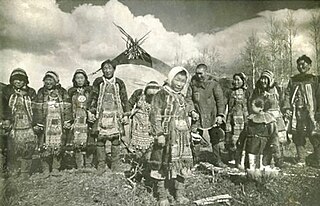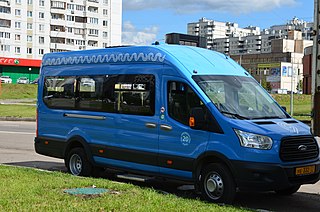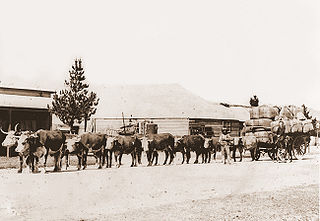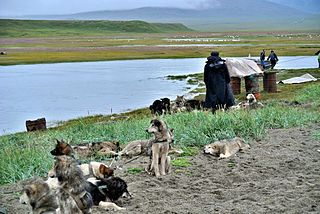
A sled, skid, sledge, or sleigh is a land vehicle that slides across a surface, usually of ice or snow. It is built with either a smooth underside or a separate body supported by two or more smooth, relatively narrow, longitudinal runners similar in principle to skis. This reduces the amount of friction, which helps to carry heavy loads.

A sled dog is a dog trained and used to pull a land vehicle in harness, most commonly a sled over snow.

A snowmobile, also known as a snowmachine, motor sled, motor sledge, skimobile, or snow scooter, is a motorized vehicle designed for winter travel and recreation on snow. It is designed to be operated on snow and ice and does not require a road or trail, but most are driven on open terrain or trails. Snowmobiling is a sport that many people have taken on as a serious hobby. Common brand names in the United States include Arctic Cat, Polaris Inc. and Ski-Doo.

Husky is a general term for a dog used in the polar regions, primarily and specifically for work as sled dogs. It refers to a traditional northern type, notable for its cold-weather tolerance and overall hardiness. Modern racing huskies that maintain arctic breed traits represent an ever-changing crossbreed of the fastest dogs.
The P-700 Granit is a Soviet and Russian naval anti-ship cruise missile. Its GRAU designation is 3M45, its NATO reporting name SS-N-19 Shipwreck. It comes in surface-to-surface and submarine-launched variants, and can also be used against ground targets.

The Imperial crown of Russia, also known as the great imperial crown, was used for the coronation of the monarchs of Russia from 1762 until the Russian monarchy's abolition in 1917. The great imperial crown was first used in the coronation by Catherine the Great, and it was last worn at the coronation of Nicholas II. It was displayed prominently next to Nicholas II on a cushion at the State Opening of the Russian Duma inside the Winter Palace in St. Petersburg in 1906. It survived the 1917 revolution and is currently on display in Moscow at the Kremlin Armoury's State Diamond Fund.

Negidals are an Indigenous ethnic group in the Khabarovsk Krai in Russia, who live along the Amgun River and Amur River.

Marshrutka or marshrutnoe taksi or routed taxicab, are share taxis found in Eastern Europe and the republics of the former Soviet Union. Usually vans, they drive along set routes, depart only when all seats are filled, and may have higher fares than buses. Passengers can board a marshrutka anywhere along its route if there are seats available.

Mode of transport is a term used to distinguish between different ways of transportation or transporting people or goods. The different modes of transport are air, water, and land transport, which includes rails or railways, road and off-road transport. Other modes of transport also exist, including pipelines, cable transport, and space transport. Human-powered transport and animal-powered transport are sometimes regarded as their own mode, but never fall into the other categories. In general, transportation is used for moving of people, animals, and other goods from one place to another. Means of transport, on the other hand, refers to the transport facilities used to carry people or cargo according to the chosen mode. Each mode of transport has a fundamentally different technological solution, and some require a separate environment. Each mode has its own infrastructure, vehicles, transport operators and operations.Transportations helps in the better utilisation of the resources of the backyard areas by linking them with the more advanced areas. It aids in the process of industrialisation and urbanization.

A working animal is an animal, usually domesticated, that is kept by humans and trained to perform tasks instead of being slaughtered to harvest animal products. Some are used for their physical strength or for transportation, while others are service animals trained to execute certain specialized tasks. They may also be used for milking or herding. Some, at the end of their working lives, may also be used for meat or leather.

An Aerosledge is a propeller-driven sledge, sleigh or toboggan which slides on runners or skis. Aerosleds are used for communications, mail deliveries, medical aid, emergency recovery, and patrolling borders in countries such as northern Russia, as well as for recreation. Aerosani were used by the Soviet Red Army during the Winter War and World War II.

The Sakhalin Husky is a critically endangered landrace and sled laika associated with Sakhalin Island and adjacent areas. They are also known Karafuto Ken, Sakhalin Laika, or Gilyak Laika. While bred primarily as a sled dog, Sakhalin Huskies are also used for hunting bear and fishing. There are approximately 20 Sakhalin Huskies remaining on Sakhalin Island.

Laikas are aboriginal spitz from Northern Russia, especially Siberia but also sometimes expanded to include Nordic hunting breeds. Laika breeds are primitive dogs who flourish with minimal care even in hostile weather. Generally, laika breeds are expected to be versatile hunting dogs, capable of hunting game of a variety of sizes by treeing small game, pointing and baying larger game and working as teams to corner bear and boar. However a few laikas have specialized as herding or sled dogs.

Visa requirements for Russian citizens are administrative entry restrictions by the authorities of other states placed on citizens of Russia. As of 20 July 2023, Russian citizens had visa-free or visa on arrival access to 115 countries and territories, ranking the Russian passport 50th in terms of travel freedom according to the Henley Passport Index.

Putin. Corruption. is an independent report on alleged corruption in Vladimir Putin’s inner circle published by the leaders of opposition liberal democratic People's Freedom Party in Russia. The report was presented by them at the press conference on 28 March 2011. This is the first large-scale project of the People’s Freedom Party.

Runet, a portmanteau of ru and net/network, is the Russian-language community on the Internet and websites. The term "Runet" was coined in 1997 by Azerbaijani-Israeli blogger Raffi Aslanbekov, known as "Great Uncle" in Russia, on his Russian-language column Great Uncle's Thoughts. Runet was popularized by early Internet users and was included in several dictionaries, including the spelling dictionary of the Russian Academy of Sciences, edited by V. V. Lopatin in 2001.

The Yakutian Laika is an ancient working dog breed that originated in the Arctic seashore of the Sakha (Yakutia) Republic. Yakutian Laikas are multipurpose laikas, with many lineages able to herd reindeer, hunt game and/or pull a sled. They are registered with the Russian Kennel Club, the FCI and the AKC's Foundation Stock Service in 2017.
KOI8-RU is an 8-bit character encoding, designed to cover Russian, Ukrainian, and Belarusian which use a Cyrillic alphabet. It is closely related to KOI8-R, which covers Russian and Bulgarian, but replaces ten box drawing characters with five Ukrainian and Belarusian letters Ґ, Є, І, Ї, and Ў in both upper case and lower case. It is even more closely related to KOI8-U, which does not include Ў but otherwise makes the same replacements. The additional letter allocations are matched by KOI8-E, except for Ґ which is added to KOI8-F.

The Nenets Herding Laika also known as the reindeer spitz or olenegonka, is an aboriginal spitz landrace of dog originating from the Yamalo-Nenets Autonomous Okrug, in Russia. Unlike other laikas, Nenets Herding Laika are less commonly used for hunting. Instead they have been selected primarily for reindeer herding ability, originally by the Nenets people, and later by reindeer herders through Russia. Nenets herding laika are thought to be the progenitor of several modern breeds, the most well-documented being the Samoyed. Despite this, the breed almost died out during the Soviet era due to lack of interest in preserving genetically purebred examples. In 1994, the Russian Kynologic Federation (RKF) approved the first official standard of the breed.

The Chukotka Sled Dog is the aboriginal spitz breed of dog indigenous to the Chukchi people of Russia.


















